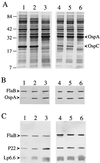Influence of cultivation media on genetic regulatory patterns in Borrelia burgdorferi
- PMID: 11349092
- PMCID: PMC98485
- DOI: 10.1128/IAI.69.6.4159-4163.2001
Influence of cultivation media on genetic regulatory patterns in Borrelia burgdorferi
Abstract
Barbour-Stoenner-Kelly II (BSKII) medium and BSKH medium both are routinely used for the cultivation of Borrelia burgdorferi. However, heretofore there have been no studies to compare how these two media affect gene expression patterns in virulent B. burgdorferi. In the present study, we found that some B. burgdorferi strain 297 genes (e.g., ospA, mlp-7A, mlp-8, p22, and lp6.6) that typically are regulated by temperature or pH displayed their predicted pattern of expression when B. burgdorferi was cultivated in BSKH medium; this was not true when spirochetes were cultivated in conventional BSKII medium. The results suggest that BSKH medium is superior to BSKII medium for gene expression studies with B. burgdorferi.
Figures




Similar articles
-
Interdependence of environmental factors influencing reciprocal patterns of gene expression in virulent Borrelia burgdorferi.Mol Microbiol. 2000 Sep;37(6):1470-9. doi: 10.1046/j.1365-2958.2000.02104.x. Mol Microbiol. 2000. PMID: 10998177
-
Effects of bovine serum albumin on the ability of Barbour-Stoenner-Kelly medium to detect Borrelia burgdorferi.J Clin Microbiol. 1990 Feb;28(2):363-5. doi: 10.1128/jcm.28.2.363-365.1990. J Clin Microbiol. 1990. PMID: 2179264 Free PMC article.
-
Comparison of isolation rate of Borrelia burgdorferi sensu lato in MKP and BSK-II medium.Int J Med Microbiol. 2006 May;296 Suppl 40:267-73. doi: 10.1016/j.ijmm.2006.01.005. Epub 2006 Mar 10. Int J Med Microbiol. 2006. PMID: 16530005
-
Evaluation of a modified culture medium for Borrelia burgdorferi sensu lato.Mem Inst Oswaldo Cruz. 2007 Dec;102(8):999-1002. doi: 10.1590/s0074-02762007000800017. Mem Inst Oswaldo Cruz. 2007. PMID: 18209941
-
Temperature-regulated expression of bacterial virulence genes.Microbes Infect. 2000 Feb;2(2):157-66. doi: 10.1016/s1286-4579(00)00272-0. Microbes Infect. 2000. PMID: 10742688 Review.
Cited by
-
Profiling of temperature-induced changes in Borrelia burgdorferi gene expression by using whole genome arrays.Infect Immun. 2003 Apr;71(4):1689-705. doi: 10.1128/IAI.71.4.1689-1705.2003. Infect Immun. 2003. PMID: 12654782 Free PMC article.
-
Molecular adaptation of Borrelia burgdorferi in the murine host.J Exp Med. 2002 Jul 15;196(2):275-80. doi: 10.1084/jem.20020770. J Exp Med. 2002. PMID: 12119353 Free PMC article.
-
Bacterial and host enzymes modulate the inflammatory response produced by the peptidoglycan of the Lyme disease agent.bioRxiv [Preprint]. 2025 May 31:2025.01.08.631998. doi: 10.1101/2025.01.08.631998. bioRxiv. 2025. Update in: PLoS Pathog. 2025 Jul 7;21(7):e1013324. doi: 10.1371/journal.ppat.1013324. PMID: 39829805 Free PMC article. Updated. Preprint.
-
Evaluation of the preventive capacities of a topically applied azithromycin formulation against Lyme borreliosis in a murine model.J Antimicrob Chemother. 2011 Dec;66(12):2814-22. doi: 10.1093/jac/dkr371. Epub 2011 Sep 15. J Antimicrob Chemother. 2011. PMID: 21921078 Free PMC article.
-
Characterization of the stringent response and rel(Bbu) expression in Borrelia burgdorferi.J Bacteriol. 2003 Feb;185(3):957-65. doi: 10.1128/JB.185.3.957-965.2003. J Bacteriol. 2003. PMID: 12533471 Free PMC article.
References
-
- Akins D R, Porcella S F, Popova T G, Shevchenko D, Li M, Norgard M V, Radolf J D. Evidence for in vivo but not in vitro expression of a Borrelia burgdorferi outer surface protein F (OspF) homologue. Mol Microbiol. 1995;18:507–520. - PubMed
-
- Alban P S, Johnson P W, Nelson D R. Serum-starvation-induced changes in protein synthesis and morphology of Borrelia burgdorferi. Microbiology. 2000;146:119–127. - PubMed
Publication types
MeSH terms
Substances
Grants and funding
LinkOut - more resources
Full Text Sources
Other Literature Sources

